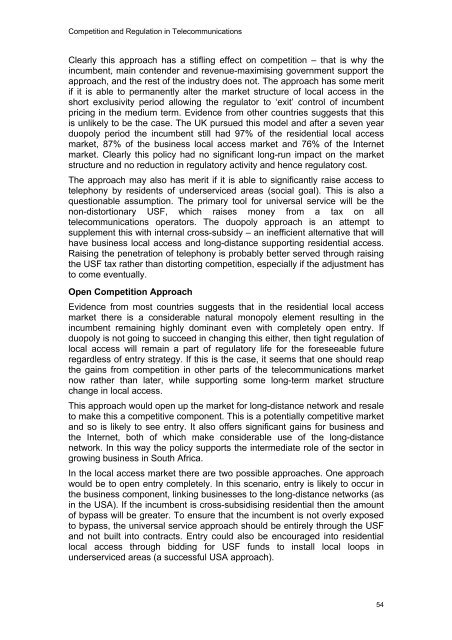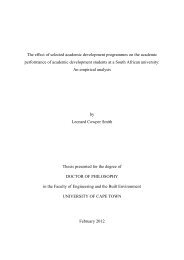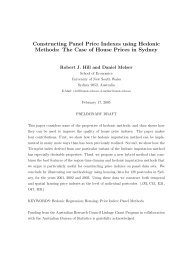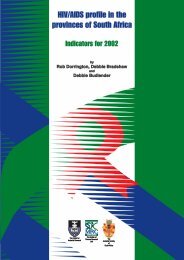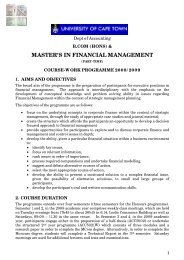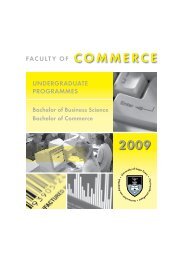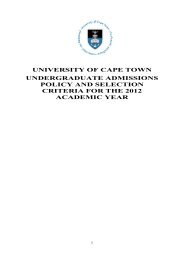Competition and Regulation in the Telecommunications Industry in ...
Competition and Regulation in the Telecommunications Industry in ...
Competition and Regulation in the Telecommunications Industry in ...
You also want an ePaper? Increase the reach of your titles
YUMPU automatically turns print PDFs into web optimized ePapers that Google loves.
<strong>Competition</strong> <strong>and</strong> <strong>Regulation</strong> <strong>in</strong> <strong>Telecommunications</strong>Clearly this approach has a stifl<strong>in</strong>g effect on competition – that is why <strong>the</strong><strong>in</strong>cumbent, ma<strong>in</strong> contender <strong>and</strong> revenue-maximis<strong>in</strong>g government support <strong>the</strong>approach, <strong>and</strong> <strong>the</strong> rest of <strong>the</strong> <strong>in</strong>dustry does not. The approach has some meritif it is able to permanently alter <strong>the</strong> market structure of local access <strong>in</strong> <strong>the</strong>short exclusivity period allow<strong>in</strong>g <strong>the</strong> regulator to ‘exit’ control of <strong>in</strong>cumbentpric<strong>in</strong>g <strong>in</strong> <strong>the</strong> medium term. Evidence from o<strong>the</strong>r countries suggests that thisis unlikely to be <strong>the</strong> case. The UK pursued this model <strong>and</strong> after a seven yearduopoly period <strong>the</strong> <strong>in</strong>cumbent still had 97% of <strong>the</strong> residential local accessmarket, 87% of <strong>the</strong> bus<strong>in</strong>ess local access market <strong>and</strong> 76% of <strong>the</strong> Internetmarket. Clearly this policy had no significant long-run impact on <strong>the</strong> marketstructure <strong>and</strong> no reduction <strong>in</strong> regulatory activity <strong>and</strong> hence regulatory cost.The approach may also has merit if it is able to significantly raise access totelephony by residents of underserviced areas (social goal). This is also aquestionable assumption. The primary tool for universal service will be <strong>the</strong>non-distortionary USF, which raises money from a tax on alltelecommunications operators. The duopoly approach is an attempt tosupplement this with <strong>in</strong>ternal cross-subsidy – an <strong>in</strong>efficient alternative that willhave bus<strong>in</strong>ess local access <strong>and</strong> long-distance support<strong>in</strong>g residential access.Rais<strong>in</strong>g <strong>the</strong> penetration of telephony is probably better served through rais<strong>in</strong>g<strong>the</strong> USF tax ra<strong>the</strong>r than distort<strong>in</strong>g competition, especially if <strong>the</strong> adjustment hasto come eventually.Open <strong>Competition</strong> ApproachEvidence from most countries suggests that <strong>in</strong> <strong>the</strong> residential local accessmarket <strong>the</strong>re is a considerable natural monopoly element result<strong>in</strong>g <strong>in</strong> <strong>the</strong><strong>in</strong>cumbent rema<strong>in</strong><strong>in</strong>g highly dom<strong>in</strong>ant even with completely open entry. Ifduopoly is not go<strong>in</strong>g to succeed <strong>in</strong> chang<strong>in</strong>g this ei<strong>the</strong>r, <strong>the</strong>n tight regulation oflocal access will rema<strong>in</strong> a part of regulatory life for <strong>the</strong> foreseeable futureregardless of entry strategy. If this is <strong>the</strong> case, it seems that one should reap<strong>the</strong> ga<strong>in</strong>s from competition <strong>in</strong> o<strong>the</strong>r parts of <strong>the</strong> telecommunications marketnow ra<strong>the</strong>r than later, while support<strong>in</strong>g some long-term market structurechange <strong>in</strong> local access.This approach would open up <strong>the</strong> market for long-distance network <strong>and</strong> resaleto make this a competitive component. This is a potentially competitive market<strong>and</strong> so is likely to see entry. It also offers significant ga<strong>in</strong>s for bus<strong>in</strong>ess <strong>and</strong><strong>the</strong> Internet, both of which make considerable use of <strong>the</strong> long-distancenetwork. In this way <strong>the</strong> policy supports <strong>the</strong> <strong>in</strong>termediate role of <strong>the</strong> sector <strong>in</strong>grow<strong>in</strong>g bus<strong>in</strong>ess <strong>in</strong> South Africa.In <strong>the</strong> local access market <strong>the</strong>re are two possible approaches. One approachwould be to open entry completely. In this scenario, entry is likely to occur <strong>in</strong><strong>the</strong> bus<strong>in</strong>ess component, l<strong>in</strong>k<strong>in</strong>g bus<strong>in</strong>esses to <strong>the</strong> long-distance networks (as<strong>in</strong> <strong>the</strong> USA). If <strong>the</strong> <strong>in</strong>cumbent is cross-subsidis<strong>in</strong>g residential <strong>the</strong>n <strong>the</strong> amountof bypass will be greater. To ensure that <strong>the</strong> <strong>in</strong>cumbent is not overly exposedto bypass, <strong>the</strong> universal service approach should be entirely through <strong>the</strong> USF<strong>and</strong> not built <strong>in</strong>to contracts. Entry could also be encouraged <strong>in</strong>to residentiallocal access through bidd<strong>in</strong>g for USF funds to <strong>in</strong>stall local loops <strong>in</strong>underserviced areas (a successful USA approach).54


